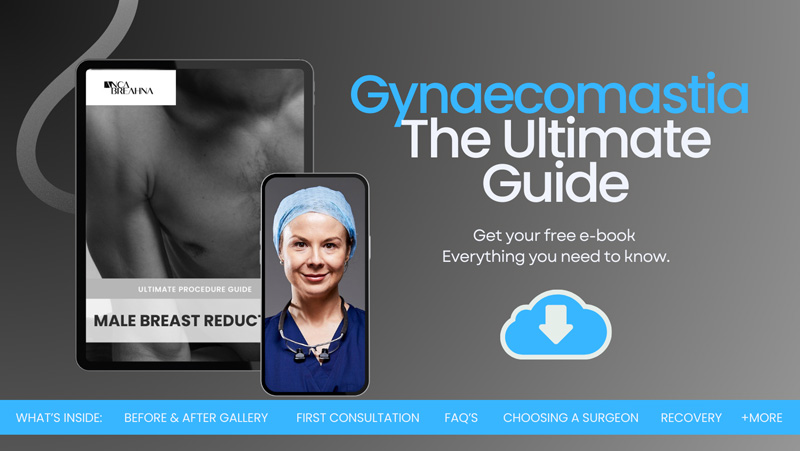
Resuming Exercise after Man Boobs Surgery
When thinking about the recovery process after gynaecomastia surgery, commonly known as man boob surgery, it’s essential to understand when you can resume exercise and physical activity.
You may be eager to return to exercise after gynaecomastia, but this eagerness must be balanced with the understanding that this surgery is a significant intervention. The body needs time to heal, and the healing process varies depending on individual health profiles and the extent of the surgery. Personal preferences in physical activity must be realigned with the new post-surgery reality, where patience and gradual progression are key. Lifestyle changes, especially in the early recovery phase, are critical. You must consider how everyday activities and exercise routines can be adapted to accommodate the healing process. Each stage of your recovery will have different limitations and possibilities, and it is important to navigate this journey with a clear understanding and a personalised approach.
In this blog, Chester Consultant Plastic Surgeon Anca Breahna will share her expert insights on the process of recovery following gynaecomastia surgery.
Download Gynaecomastia Guide 2024

How Are The First Few Weeks after Gynaecomastia?
In the first few weeks after your gynaecomastia surgery, your body enters a critical healing phase. It’s a time when your body starts to repair and adjust to the changes post-surgery. You’ll likely notice:
- Swelling and Bruising: It’s common to see swelling and bruising around the operated area. This is your body’s natural response to the surgery
- Sensitivity and Soreness: You may experience discomfort and tenderness in the chest area. This is a normal part of the healing process
- Limited Range of Motion: Your upper body movement will be restricted. It’s important to avoid stretching or lifting actions that could strain the surgical site
Day-to-Day Activities
During this time, your daily activities will need to be adjusted. It’s important to:
- Take Adequate Rest: Your body needs time to heal. Ensure you get plenty of sleep and avoid physically taxing activities
- Engage in Light Movement: While rest is important, so is movement. Gentle walking is beneficial to maintain circulation and reduce the risk of blood clots
- Follow Post-Operative Instructions: Anca will provide specific guidelines on how to care for the surgical area, including how to bathe and dress
Pain Management
Pain and discomfort are expected, but manageable. Consider the following:
- Use Prescribed Medication: If you’ve been prescribed pain relief medication, use it as directed to manage discomfort
- Apply Cold Compresses: To alleviate swelling, gentle use of cold compresses can be helpful. Be sure to follow Anca’s advice on this
Nutrition and Hydration
Good nutrition plays an important role in your recovery. Focus on:
- Eating Balanced Meals: Consume a diet rich in vitamins and proteins to aid in healing
- Staying Hydrated: Drink plenty of water to help flush out toxins and keep the body hydrated
Wound Care
Proper care of the surgical area is imperative for a smooth recovery:
- Keep the Area Clean: Follow instructions on how to clean the surgical site to prevent infection
- Wear Compression Garments: These garments help reduce swelling and support the healing tissues
When to Seek Medical Advice
Stay alert to any signs that may warrant medical attention, such as:
- Increased Pain or Swelling: If pain intensifies or swelling increases, it might be a sign of complications
- Signs of Infection: Fever, excessive redness, or discharge from the incision sites should be reported to Anca’s team immediately
Gradual Resuming of Exercise after Gynaecomastia
After the initial recovery phase from your gynaecomastia surgery, it’s time to gradually reintroduce physical activity into your routine. This stage is about finding a balance between aiding your recovery and avoiding overexertion.
- Weeks 2-3: You can start with light aerobic exercises like brisk walking or using a stationary bike. These activities help improve circulation and can aid in reducing swelling
- Weeks 4-6: Depending on how you feel, you may increase the duration and intensity of aerobic exercises. Swimming can also be a good option, but do check with Anca before you begin
- After Week 6: If Anca agrees, you can start including low-impact strength training exercises. Begin with lighter weights and focus on other body parts before gradually introducing chest exercises
Monitoring and Adjusting Your Exercise Routine after the Surgery
Paying attention to your body’s response to physical activity is essential during this phase.
- Look for Signs of Overexertion: If you experience increased swelling, pain, or any discharge from the incision sites after exercising, it may be a sign you’re pushing too hard
- Stay in Touch with Anca’s Team: Regular check-ups are important. Anca can provide advice on when and how to safely increase your physical activity
- Adjust According to Your Body’s Response: Your recovery may not be linear. Some days you might feel capable of more, and other days less so. Adjust your activity level accordingly
Flexibility and Strength Training after Gynaecomastia
As your recovery progresses, integrating flexibility and strength training exercises can be beneficial.
- Start with Light Stretching: Gentle stretching exercises can help maintain flexibility and range of motion. Be cautious not to stretch the chest area excessively
- Gradual Strength Training: Begin with lower weights and fewer repetitions. Focus on overall body strength before targeting the chest area
Building Endurance
Cardiovascular fitness is an important part of your overall health and aids recovery.
- Gradual Increase in Cardio: Build up your cardio workouts gradually. Start with short sessions and slowly increase the time as your endurance improves
- Choose Low Impact Cardio: Activities like cycling, swimming, or using an elliptical machine are excellent low-impact options that reduce strain on your body
Lifestyle Considerations after Gynaecomastia
Your approach to physical activity post-surgery should reflect all aspects of your health:
- Balanced Diet: A nutritious diet supports your increased activity levels and aids in healing
- Adequate Rest: Ensure you get enough rest between workouts. Your body heals and strengthens during rest periods
Listening to Your Body
Remember, every individual’s recovery process is unique.
- Be Patient with Your Progress: It’s important to give your body the time it needs to adapt to increased physical demands
- Stay Motivated: Set small, achievable goals to keep yourself motivated. Celebrate the small victories along your recovery journey
When to Progress with Exercise after Gynaecomastia
Knowing when to progress to more strenuous activities is important.
- Guidance from Your Surgeon: Anca is the best source of advice on when to introduce more challenging exercises
- No Pain, No Gain is a Myth: If an exercise causes pain, stop. Pain is an indicator that you might be pushing too hard
Gradually reintroducing exercise post-gynaecomastia surgery requires a careful, patient approach. Monitor your body’s responses, adjust your routine accordingly, and always prioritise your recovery. With time, you’ll find your strength and endurance returning, allowing you to enjoy the benefits of your surgery fully.
Resuming Regular Exercise after Gynaecomastia
Once you’ve completed the initial stages of recovery and gradually increased your physical activity, you’re likely to reach a point where you can consider resuming more strenuous exercises, including strength training and rigorous workouts. This stage, typically starting around the 6-8 week mark post-surgery, is a significant milestone in your recovery journey.
- Start Slow with Strength Training: Begin with lower weights and fewer repetitions. Focus on overall body strength. It’s important to reintegrate chest exercises slowly and carefully, to avoid any strain on the surgical area
- Incorporate a Variety of Exercises: Include a mix of cardiovascular, strength, and flexibility exercises in your routine. This balanced approach helps in overall fitness and reduces the risk of injury
- Listen to Your Body: Pay attention to how your body responds during and after workouts. If you experience any discomfort or pain, particularly in the chest area, take it as a sign to slow down
Proper technique and form are more important than ever during this phase:
- Seek Professional Guidance: If possible, work with a fitness professional who can guide you on the correct form and technique, especially for chest exercises
- Avoid Heavy Lifting Initially: Even if you feel capable, avoid lifting heavy weights too soon. Gradually increase the weight as your strength and confidence improve
Long-term Health and Fitness Goals
As you resume regular exercise, it’s a good time to reflect on your long-term health and fitness goals. This reflection can help guide your exercise choices and keep you motivated.
- Set Realistic Goals: Set achievable fitness goals that align with your current physical condition and overall health objectives. These could range from improving cardiovascular health to gaining muscle strength
- Understand Your Body’s New Limitations: Post-surgery, your body might react differently to certain exercises. Be open to adapting your fitness regime to these new changes
- Focus on Sustainable Habits: Rather than chasing quick results, aim for a sustainable and consistent exercise routine that you can maintain in the long run
Maintaining a Balanced Routine
A balanced exercise routine is important to long-term fitness.
- Include Cardiovascular Exercises: Activities like jogging, cycling, or swimming are excellent for improving heart health and stamina
- Regular Strength Training: Continue to incorporate strength training, ensuring you cover all major muscle groups
- Flexibility and Balance Exercises: Practices like yoga or Pilates can enhance flexibility, balance, and core strength
FAQs about Gynaecomastia Surgery
How soon after gynaecomastia surgery can I start doing cardio exercises?
- Light cardio exercises like walking can be started within the first 2-3 weeks post-surgery, depending on how you feel and Anca’s advice. More intensive cardio should be delayed until at least 6 weeks post-surgery, and only after getting a green light from your surgeon.
Is it normal to feel tightness in the chest when resuming exercise after gynaecomastia surgery?
- Yes, it’s quite common to feel some tightness or discomfort in the chest area when you first resume exercises after surgery. This should gradually improve. However, if the tightness is accompanied by sharp pain, significant swelling, or any other concerning symptoms, it’s important to consult your surgeon.
Can I do push-ups and chest exercises after gynaecomastia surgery?
- Yes, but only after a sufficient recovery period, typically around 6-8 weeks post-surgery, and with your surgeon’s approval. Start with lower intensity and gradually increase as your comfort and strength improve. Be particularly cautious with exercises that put direct strain on the chest.
Will exercise improve the results of my gynaecomastia surgery?
- Exercise, particularly a combination of cardio and strength training, can enhance the overall results of your surgery by improving muscle tone and overall physical fitness. But the exercise should be resumed gradually and carefully to avoid complications.
What are the signs that I am overdoing it with exercise after gynaecomastia surgery?
- Signs of overdoing exercise include increased pain or discomfort in the surgical area, excessive swelling, unusual discharge or bleeding from the incision sites, and any form of sharp or persistent pain. If you experience any of these symptoms, it’s important to reduce your activity level and consult Anca.
Further Reading about Male Procedures with Consultant Plastic Surgeon Anca Breahna
- Read more about How to Get Rid of Puffy Nipples in Men
- Read more about Who is the Best Gynaecomastia Surgeon in the World?
- Read more about 8 Myths about Breast Reduction Surgery
- Read more about What is a Tummy Tuck Procedure?
- Read more about Excess Skin after Weight Loss – Causes and Solutions
- Read more about Recovery after Gynaecomastia Surgery
- Read more about UK’s Most Popular Plastic Surgery for Men
- Read more about How to Get Rid of Man Boobs – Causes and Treatment Options
- Read more about What Are Gynaecomastia Surgery Scars Like?
Medical References about Gynaecomastia
- Enlarged Breasts in Men (gynecomastia) – Mayo Clinic
- Gynaecomastia (Male Breast Reduction) – Australian Society of Plastic Surgeons
- Gynecomastia: Surgery, Treatment, Causes, and Symptoms – Medical News Today
- What Is Gynecomastia? How Does It Affect Men and Boys? – WebMD
- Male Breast Reduction What to Expect -Cleveland Clinic



 Ms Anca Breahna, PhD, MSc, FEBOPRAS, FRCS (Plast) is a highly regarded Consultant Plastic Surgeon specialising in the field of Aesthetic and Reconstructive Plastic Surgery. Anca performs a range of
Ms Anca Breahna, PhD, MSc, FEBOPRAS, FRCS (Plast) is a highly regarded Consultant Plastic Surgeon specialising in the field of Aesthetic and Reconstructive Plastic Surgery. Anca performs a range of 